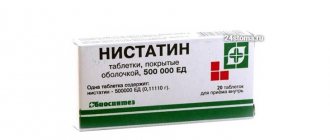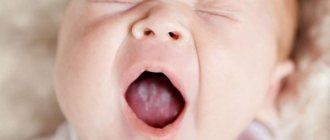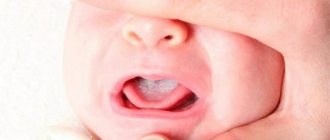From this article you will learn:
- what is oral candidiasis,
- what does thrush look like on the tongue in adults,
- effective tablets against thrush,
- causes of thrush in the mouth of a baby.
Thrush in the mouth is a type of fungal infection in which the oral mucosa is affected by yeast-like fungi of the genus Candida (primarily the species Candida albicans). The main symptom of thrush is the appearance on the mucous membrane of a whitish coating in the form of flakes, reminiscent of snow or cottage cheese flakes. Thrush can occur on the mucous membrane of the tongue, cheeks, hard and soft palate, tonsils, palatine arches, and also in the corners of the mouth.
The term “thrush” is only a colloquial expression, and in dentistry, the professional term used to refer to this disease is oral candidiasis. Most often, this disease develops against the background of reduced immunity, and equally in both men and women. Candidiasis in the mouth can also develop in infants, and most often this occurs at 4 weeks from birth (rarely at 1 week, or in children older than 6 months).
Thrush in the mouth: photo
It is important to understand that thrush in the mouth in adults or infants is not some banal fungal infection of the mucous membrane that can be “caught” somewhere and then easily cured. Fungi of the genus Candida are “opportunistic microorganisms” and cause oral infections only if the “host” has a predisposing condition. Those. yeast-like fungi are part of the normal microflora of the human oral cavity, never showing their pathogenic properties in most cases.
And if oral candidiasis does occur, most often this is a marker of serious (not yet diagnosed) diseases, pathologies of the immune system. If before 1980, thrush in the mouth occurred mainly only in either very young or elderly patients, now due to the widespread prevalence of immunodeficiency conditions (diabetes, leukemia, HIV/AIDS), due to the widespread use of immune-suppressing drugs drugs - candidiasis is typical for any age.
Oral candidiasis: causes
There are many subspecies of fungi of the genus Candida. Previously, candidiasis in the mouth in approximately 80% of cases was caused by the species Candida albicans (C.albicans), and only in other cases by the more pathogenic species C.glabrata, C.krusei, C.tropicalis. Currently, C. albicans is the cause of candidiasis in only 50% of patients, i.e. The causes of candidiasis are increasingly becoming the most aggressive species of Candida fungi, which are resistant to many antifungal drugs.
Fungi of the genus Candida under a microscope –
We have already said that the main reason for the appearance of thrush in the mouth is a weakened immune system. For example, this is typical for very young or, on the contrary, very old age. This is typical for patients who take systemic antibiotics and corticosteroid drugs. This is also typical for patients with immunodeficiency conditions - patients with diabetes mellitus, blood diseases (neutropenia, anemia), intestinal dysbiosis, as well as for patients with HIV/AIDS (in the latter, oral candidiasis is diagnosed in 90% of cases). At risk are patients with oncology, including those who have undergone chemotherapy and radiation therapy), as well as women taking oral contraceptives.
Thrush in the mouth of a baby (newborn) is most often associated with the presence of undiagnosed vaginal candidiasis in a woman, which, according to statistics, is present in at least 25-30% of pregnant women. And most often, infection of a newborn occurs precisely during its passage through the birth canal. Thrush in the mouth of children can also be associated with breastfeeding if the woman’s nipples are colonized by fungi of the genus Candida. Infection can occur even simply because you tasted your child's food with his spoon or kissed your child on the lips.
Learn more about some of the causes of thrush –
- After taking antibiotics, the oral cavity normally contains many types of microorganisms that not only coexist, but also inhibit each other’s growth. Taking broad-spectrum antibiotics eliminates some types of bacteria in the oral cavity, which disrupts the balanced composition of the microflora. The disappearance or reduction of certain types of bacteria can lead to the growth of Candida fungi.
- While taking corticosteroids - in patients with diabetes, the use of inhaled corticosteroids can cause oral thrush.
According to statistics, thrush occurs in approximately 5-10% of adults and 1% of children using inhaled corticosteroids. In cases where the cause of thrush is inhaled steroids, candidal lesions usually have the appearance of erythema (redness) rather than snow flakes. Candidiasis lesions appear precisely in those areas of the mucous membrane with which the steroid came into contact (as a rule, this is the back of the tongue, the palate). For this reason, patients taking such medications are advised to rinse their mouth with water after each use of corticosteroids.
- Diet – Research shows that a diet high in carbohydrates also predisposes to oral candidiasis, and therefore it is very important to avoid sweets, including sugar-sweetened drinks, in these patients.
Research shows that the growth of Candida and its adhesion to the mucosa are significantly enhanced in the presence of sugars (glucose, galactose, sucrose). It should also be taken into account that malnutrition can lead to a lack of iron, vitamin B12, and folic acid in the body, which is also a predisposing factor to oral candidiasis.
- Taking oral contraceptives - systematic use of contraceptives (containing estrogens, progestin) leads to an increase in the concentration of glucose in the blood, saliva, and vaginal secretions. The consequence of this is an increase in both the frequency of Candida carriage and the incidence of candidiasis of the oral mucosa, vagina, etc.
- Smoking and other factors – Other factors may include smoking, endocrine disorders (such as diabetes), and the presence of certain diseases of the oral mucosa such as lichen planus and leukoplakia. Often oral candidiasis occurs in patients with a folded tongue or after tongue piercing.
- In patients with removable dentures – most often in patients with removable dentures, candidiasis occurs due to insufficient hygiene of the denture.
In this case, the prosthesis is covered with a biofilm containing a large number of fungi of the genus Candida. At the same time, when chewing, a removable denture always rubs against the mucous membrane of the prosthetic bed, reducing its barrier properties (this facilitates the penetration of fungal microflora deep into the mucous membrane). For this reason, denture disinfection is a very important part of the prevention and treatment of oral candidiasis in people with removable dentures. A predisposing factor may be if the patient does not remove his prosthesis while sleeping. In this case, the mucous membrane is constantly deprived of oxygen and washed with saliva, which creates the preconditions for the proliferation of bacteria and fungi. Another reason may be that the prosthesis does not fit well with the tissues of the prosthetic bed (for example, because its service life has expired), and therefore it injures the mucous membrane. Such microtraumas to the mucosa also contribute to the onset of the development of oral candidiasis.
- Chronic dry mouth - a decrease in the amount of saliva and the content of various enzymes and antibodies in it is an important predisposing factor in the development of oral candidiasis. Dentists call constant dryness in the mouth the term “xerostomia.” Its treatment is a big problem in dentistry.
- Poor oral hygiene – untreated carious teeth and irregular tooth brushing increase the risk of developing candidiasis. Infection in carious defects, soft microbial plaque, hard dental deposits worsen the local immunity of the oral mucosa. Because of this, Candida fungi begin to actively multiply and can penetrate deep into the oral mucosa.
- Oral candidiasis in an infant - at a very young age, the immune system has not yet fully developed. Acute pseudomembranous candidiasis occurs in approximately 5% of newborns. Candida species are acquired from the mother's vaginal canal during childbirth. At an early age, the immune system has not yet fully developed and therefore infants do not have an individual immune response to Candida fungi (infant antibodies to fungi are usually supplied in the mother's breast milk).
Why candidiasis does not develop in people with good immunity:
Patients with a well or satisfactorily functioning immune system almost never get oral thrush (even if Candida fungi are present on the oral mucosa). Prevention of candidiasis is normally ensured by the functions of the innate immune response, and above all, by the effectiveness of the phagocytosis process (24stoma.ru). Let us recall that phagocytosis is the process of absorption and digestion of infectious agents by cells of the immune system - primarily professional phagocytes (macrophages, neutrophils).
The development of candidiasis will also be facilitated by low opsonizing activity of blood cells (opsonization is the process of adsorption of antibodies and complement factors on the surface of infectious agents, which allows for increased phagocytosis). The threat of developing a fungal infection is increased by the functional insufficiency of the T- and B-cell immunity, low levels of immune response mediators (γ-interferon, interleukin-1α, tumor necrosis factor α). A consultation with an immunologist + a general blood test with an extended leukocyte formula and an immunogram will help identify defects in the immune system.
Causes
There are many conditions for the occurrence of thrush:
- if the rules of hygiene for a newborn are not observed - there is no boiling regime for feeding supplies, breastfeeding hygiene is not observed, unwashed toys, teethers that are not treated daily, and in general all items that are used in caring for the child;
- if the mother suffers from candidiasis, then most likely the disease will be transmitted to the baby through contact;
- if the mother has vaginal candidiasis, it will be transmitted to the child during childbirth (and even during cesarean section);
- with frequent regurgitation, a favorable environment for the development of fungus is formed in the mouth;
- if the baby drinks little liquid, then thrush may also develop on the dry mucous membrane of the mouth;
- Candida fungi multiply quickly in a sweet environment, so it is undesirable to give your child sweets, especially drinks;
- teething, diarrhea, colds - all this weakens the immune system, which means the possibility of fungal growth;
- premature babies also often suffer from thrush;
- antibiotics suppress the natural microflora of the body and enable the disease to intensify;
- you can become infected during long-term treatment in a hospital;
- for chronic diseases - for example, diabetes.
Thrush in the mouth: symptoms
When oral thrush occurs in adults, the symptoms can vary greatly from patient to patient. The fact is that oral thrush (oral candidiasis) comes in four main types, each of which has its own characteristic symptoms. There are the following 4 main forms of this disease:
- acute pseudomembranous candidiasis,
- acute or chronic atrophic candidiasis,
- chronic hyperplastic candidiasis.
Below we will analyze the features of each form, but despite the differences in symptoms, their treatment will be carried out almost the same.
1) Acute pseudomembranous candidiasis –
This form of oral thrush is usually asymptomatic. There may only be discomfort due to the presence of white films or plaques rising above the oral mucosa (Fig. 4-6). In mild cases, the plaques are single, easily removed by scraping, and in this case a bright red mucous membrane is found underneath them.
In severe cases, the plaques, increasing in size, merge with each other, which leads to damage to almost the entire mucous membrane. When plaques thicken, they become very difficult to scrape off. This type of candidiasis often develops in infants, in patients after taking antibiotics, corticosteroids or immunosuppressants, in patients with an impaired immune status (due to leukemia, HIV).
Pseudomembranous candidiasis (Fig. 4-6) –
2) Acute and chronic atrophic candidiasis –
In acute atrophic candidiasis, the patient may feel as if the mouth has been scalded by hot liquid. At the same time, there is no white coating or plaques, and the mucous membrane is bright red. Another possible symptom is a metallic, acidic, salty or bitter taste in the mouth, as well as dry mouth. Most often, acute atrophic candidiasis develops after taking broad-spectrum antibiotics or inhaled corticosteroids.
With chronic atrophic candidiasis, redness of the mucous membrane and a burning sensation are also observed. Most often, this form of oral thrush occurs in patients with removable dentures, and therefore it is sometimes also called denture stomatitis. In some classifications, atrophic candidiasis can also be called “erythematous” (from the word “erythema” - redness).
What does atrophic candidiasis look like (Fig. 7-9) –
3) Chronic hyperplastic candidiasis –
It occurs mainly only in adults and is quite rare (in relation to other forms of candidiasis, the frequency of its occurrence is no more than 5%). Most often it occurs on the mucous membrane of the cheeks, near the corners of the mouth, on the back of the tongue, and also on the soft palate. It is characterized by the appearance of white plaques that grow and merge over time, gradually acquiring a yellowish color. At an advanced stage, the surface of the plaques becomes rough and knotty.
Hyperplastic candidiasis differs from pseudomembranous candidiasis in that the plaques in this case cannot be removed by careful scraping. Most often, hyperplastic candidiasis occurs in middle-aged men who smoke, and the typical localization of the process is the mucous membrane in the area of the corners of the mouth (commissures), as well as on the tongue. A clinical study (“Candidal leukoplakia and carcinoma. A possible relationship” Cawson, Binnie) found that hyperplastic candidiasis tends to transform into cancer. Those. it can be regarded as a precancerous disease.
Important: most types of oral candidiasis are painless, and are manifested only by the presence of lesions on the oral mucosa; sometimes a burning sensation may be present. This is why candidiasis can sometimes be misdiagnosed as “burning syndrome.”
To make a correct diagnosis, it is very important to conduct a cytological examination of plaque taken from the oral mucosa. This is all the more important because very often, an abundant accumulation of non-fungal microflora (especially on the tongue) can resemble a fungal infection of the mucous membrane.
Complications of oral candidiasis (in children and adults) –
Very often, adults resort to self-medication, which often only leads to the spread of a fungal infection. Candidiasis in the mouth can quickly spread to the esophagus, causing esophagitis (manifested by pain when food passes through the esophagus, which is felt as chest pain). The process can spread to the larynx, a symptom of which may be hoarseness.
Also, untreated oral candidiasis can lead to the spread of the process to the skin (chronic mucocutaneous candidiasis), which mainly occurs in patients with pathology of the immune system, namely with defects in the functioning of T-lymphocytes, with neutropenia. Lack of treatment or untimely treatment of the hyperplastic form of candidiasis can lead to the development of cancer in the oral cavity. If thrush occurs in the baby’s mouth, the most common complication is diaper dermatitis (the appearance of a candidal rash on the baby’s body).
Symptoms of thrush in a newborn baby
If the plaque is accompanied by the following symptoms, you need to sound the alarm:
- the baby refuses to take the breast, becomes capricious, spits out the pacifier;
- increased salivation;
- drowsiness, loss of appetite;
- swelling of the oral mucosa;
- the formation of shallow painful ulcers under a layer of plaque;
- the plaque itself is removed with a finger;
- whitish discharge has a sour odor;
- there is redness and/or swelling under the plaque;
- plaque spots increase;
- the appearance of cheesy plaques on top of the plaque;
- body temperature constantly remains around 37.5 degrees.
Anti-thrush medications –
We have already said above that oral candidiasis is increasingly rarely caused by the subspecies Candida albicans, which responds quite well to antifungal therapy.
Increasingly, patients are being inoculated with the most pathogenic aggressive species of fungi of the genus Candida - such as C.glabrata, C.krusei and C.tropicalis, which not only show resistance to many antifungal drugs, but also more often create microbial associations with other microorganisms (staphylococci, streptococci and etc.). All this complicates the treatment of oral thrush and also contributes to the development of relapses. Therefore, the most important thing to do before treating oral thrush in adults is to conduct a cytological examination. It will not only confirm the diagnosis of “oral candidiasis,” but also determine the sensitivity of Candida fungi isolated from a particular patient to the main antifungal drugs. It is systemic antifungal drugs that will be the basis for the treatment of oral candidiasis - especially severe and moderate forms. Treatment of mild primary forms of the disease can be carried out using topical agents.
How to treat candidiasis in the mouth -
The article is for informational purposes only, and we urge you not to self-medicate, despite the fact that some antifungal drugs are still available over the counter. You need to start with a microbiological study, and also a test for HIV infection.
Microbiological test - before starting to take antifungal drugs, it is very important to perform a microbiological test (culture of material from your oral cavity - identifying the amount of Candida, as well as determining the sensitivity of Candida to the main antifungal drugs). Please note that the analysis must include not only sensitivity to drugs, but also the number of Candida fungi.
The latter will make it possible to distinguish acute or chronic fungal infection from a banal carriage and, thus, confirm the diagnosis. Different laboratories may use different methods to determine antifungal susceptibility. The cheapest and most inaccurate is a Russian-made test that determines sensitivity to 6 antifungal drugs using the disk diffusion method (using disks produced by the Scientific Research Center for Physics, Russia). It is best if sensitivity to drugs is analyzed on a VITEK analyzer, France.
Treatment of oral candidiasis takes an average of 12-15 days (until the symptoms of the disease completely disappear). However, in patients with chronic candidiasis who have already had repeated relapses, maintenance courses of therapy will also be required. In case of a widespread process, treatment of the disease should be carried out by a dentist - in collaboration with doctors of other specialties (general practitioner, gynecologist, mycologist).
1) Local treatment for mild primary form of the disease -
Abroad, there are a large number of drugs for the treatment of mild forms of oral candidiasis, intended for local use in the oral cavity. These are special mucoadhesive tablets with Miconazole 50 mg, which are taken only once a day. These are lozenges with Clotrimazole 10 mg, which dissolve in the mouth in about 20 minutes and should be taken 5 times a day. This is a special oral suspension of Nystatin 100,000 Units/ml, which is taken 5 ml 4 times a day (this suspension is kept in the mouth for several minutes and then swallowed).
But all these drugs are not available in Russia (although some of them will be available to you, for example, if you live in Ukraine). But let's look at what is available to residents of Russia, and we'll start with the simplest.
1) The first option is tablets with Nystatin, 500,000 units, which can be used for resorption - 1 tablet. 4 times a day, i.e. approximately every 6 hours. For children, a single dosage will be 125 thousand units or 250 thousand units, depending on age, and the dosage regimen will be similar. Nystatin is not absorbed through the oral mucosa and into the gastrointestinal tract, but has an unpleasant taste and can occasionally cause nausea, vomiting and diarrhea. Additionally, this is a prescription drug and should only be used as directed by a doctor.
2) Another antifungal drug for topical use in the oral cavity is Amphotericin B, which is sold in 50 mg bottles (for suspension). This drug is a more effective analogue of nystatin. It is usually used for intravenous administration in severe systemic forms of candidiasis. However, there is a large number of studies, as well as clinical practice, when the suspension was used for use in the oral cavity. It must be said that “Amphotericin B” (as well as Nystatin) is practically not absorbed into the gastrointestinal tract or through the oral mucosa. The suspension is used 3 times a day (each time a 50 mg bottle is diluted with 5 ml of solution). Remember that this is also a prescription drug and should only be used as directed by a doctor.
3) Probably the best option is the drug “Diflucan powder”, which contains fluconazole and is intended for preparing a suspension. After dilution, 1 ml of suspension will contain 10 mg of fluconazole. For erythematous (atrophic) form of candidiasis, you need to use 50 mg 1 time per day for 7-14 days, but for pseudomembranous or hyperplastic candidiasis, the dosage is already 100 mg 1 time per day. The suspension should be kept in the mouth for a few minutes (rinse) and then swallowed. One bottle costs from 500 rubles, and is enough for 7 applications of 50 mg each.
Provided that the patient's Candida fungi are equally sensitive to all 3 drugs, a fluconazole suspension will be more effective than nystatin (since the latter has poor adhesion to the oral mucosa), and show the same effectiveness as an Amphotericin suspension. Please note that Diflucan powder for suspension is also only a prescription drug that is not intended for self-medication and should be used only as prescribed by a doctor.
Additional local therapy –
As additional local therapy, solutions for rinsing the oral cavity, as well as antifungal drugs in the form of gels (for application to the affected areas of the oral mucosa) can be used.
- best of all is an antiseptic solution of Chlorhexidine 0.2%,
- Warm soda rinses can also have a weak effect,
- gel with miconazole (for applications to the oral mucosa).
Moreover, the use of the antiseptic Chlorhexidine in addition to therapy with antifungal agents is strongly recommended for the development of candidiasis while wearing removable dentures, as well as against the background of poor oral hygiene.
2) Systemic therapy for moderate and severe oral candidiasis -
The first line of treatment for oral thrush in adults (for moderate to severe oral candidiasis) is fluconazole tablets. It has the advantage that, unlike nystatin and amphoterecin, firstly, it is well absorbed in the intestine, and secondly, it penetrates into saliva in large quantities. Before starting to take the drug or in the first days of taking it, it is very important to consult a dentist and remove all supra- and subgingival dental plaque, which, among other things, is a reservoir of Candida fungi in the oral cavity.
The same applies to patients with removable dentures, who will also need to undergo ultrasonic cleaning of the remaining teeth, as well as professional disinfection of the denture. What else is important to know. We have already said above that fungi of the genus Candida quite often demonstrate resistance to fluconazole (especially in patients with repeated relapses of thrush). For example, while Candida albicans shows good sensitivity to fluconazole, the fungal species C. glabrata and C. krusei show resistance in approximately 35% and 75% of cases, respectively.
Therefore, fluconazole therapy should be started only after a microbiological examination - culture of material from your oral cavity and identification of the sensitivity of the fungal flora to the main antifungal drugs. If the study shows the sensitivity of your Candida fungi to fluconazole, it is taken in a dosage of 150 mg 1 time per day (treatment course is 7-14 days). If we are talking about treating another relapse of oral candidiasis, then suppressive therapy will also be required. This means after completing the main course of treatment, you will have to continue taking fluconazole 100 mg 3 times a week. The duration of the course of suppressive therapy is determined by the doctor.
If Candida is resistant to fluconazole –
In case of insensitivity to fluconazole, Itraconazole capsules are first prescribed (taken only as prescribed by a doctor - usually 200 mg once a day, duration of therapy is usually 28 days). This is a prescription drug that, due to side effects, is not suitable for self-medication and should therefore only be used when prescribed by a doctor. Other drugs that can be used for fluconazole resistance include Voriconazole, Posaconazole, and Isavuconazole.
By the way, the basic dosage of 100 mg per day prescribed in the instructions for Itraconazole is much less effective than a dosage of 200 mg per day. This is confirmed by clinical studies, and this is especially true for patients with weakened immune systems and in the presence of aggressive subspecies of fungi of the genus Candida - such as C.glabrata and C.krusei. The same applies to the duration of use. For example, the instructions for intraconazole only say about 15 days of therapy (and not 28 days), but in case of weakened immunity, or in the presence of aggressive strains of Candida, such a duration of treatment is highly likely to lead to the development of relapses of candidiasis in the near future.
Table 1 - “Resistance of antifungal drugs to different types of fungi of the genus Candida.”
Treatment of thrush in a child
Be sure to consult a doctor so that he can assess the degree of development of the disease and prescribe the correct treatment!
Eliminate the conditions that cause the disease:
- if thrush was transmitted from the mother or the baby is breastfed, the mother must also be treated;
- introduce a hygiene regimen for the baby and mother: treat the oral cavity and all objects that the baby puts in his mouth (pacifiers, teethers, toys) with a soda solution (4 teaspoons per 1 liter of water);
- after feeding, you need to remove plaque from the oral cavity;
- The baby’s clothes are washed at a water temperature of at least 50-60 degrees;
- thoroughly clean nipples and breasts before each feeding of the baby;
- when breastfeeding, it is necessary to exclude fried, sweet, fatty, flour, marinades, pickles, citrus fruits and red fruits from the mother’s diet;
- introduce a drinking regimen for the child that is appropriate for his age and weight;
- take your baby for a walk every day in the fresh air;
- observe the temperature regime in the child’s room, monitor the humidity level.
Treatment with soda. Such treatment can be carried out only at the initial stage of thrush and only after consultation with a doctor.
Algorithm of actions:
- Make a soda solution: dissolve 5 g of soda in 200 ml of warm boiled water;
- moisten a sterile bandage or gauze, previously wrapped around the finger;
- The baby's oral mucosa and tongue are wiped, without pressure, gently. It is important not to remove plaque, but rather to wipe it, so as not to injure the child’s already inflamed oral cavity;
- In order for the child to open his mouth, you need to gently press the chin with your thumb and try to hold it in this position until the end of treatment;
- the mouth and tongue are treated every 2-3 hours for 5-7 days;
- Nipples, breasts and all nipples and pacifiers used by the baby must be treated with a soda solution;
- Before feeding, treat the nipple with a soda solution if the child is bottle-fed, or the nipple if breastfeeding.
Treatment with medications (do not start treatment without consulting your doctor!):
- local products for treating the oral mucosa - ointments and medications (Miramistin, Candide, Nystatin, Vinilin). The oral cavity is treated at least 4 times a day with cotton swabs or a sterile bandage wrapped around a finger;
- systemic antifungal drugs - only as prescribed by a doctor, if local treatment of the lesions does not produce results;
- children's antipyretic and painkillers.
Folk remedies against thrush:
- If you are not allergic to honey, you can do honey rubbing, since honey, despite the fact that it is sweet, has an antimicrobial effect and kills fungi. Honey and water are mixed in a ratio of 1: 2, as with soda, wipe every 2-3 hours for several days in a row;
- infusions of oak bark, sage, chamomile, calendula flowers: 1 g of herb per 200 ml of boiling water, leave for 1 hour. For each procedure you need to make a fresh infusion;
- a very weak, slightly pink solution of potassium permanganate. Wipe according to the same pattern.
Do not use brilliant green or borax! They can cause burns to the baby's sensitive mucous membranes.
Important points in the treatment of oral candidiasis -
There are several problems in treating candidiasis of any location. The first problem is that fungi of the genus Candida can be located not only on the surface of epithelial cells of the mucous membrane, but are also capable of germinating inside epithelial cells. In this case, the mucopolysaccharide membrane of the host cell will protect the fungi not only from phagocytes (which must find, absorb and digest infectious agents), but also, to a certain extent, from antifungal drugs. In this case, higher dosages of drugs and longer courses of treatment (including suppressive therapy) may be required.
Another problem may be an insufficient immune response (for example, incomplete phagocytosis of Candida fungi). In the absence of immunocorrection with the help of immunomodulators, this sharply increases the risk of developing chronic candidiasis and subsequent relapses. Among the immunomodulators, we can recommend the prescription drug "Cycloferon" (in the form of intramuscular injections), but it should be used only after the recommendation of a doctor. If a slight correction of the immune status is necessary, you can use Cycloferon tablets.
It is very important to carry out treatment while sanitation of the oral cavity, i.e. it is necessary to cure all carious teeth, foci of chronic inflammation in the oral cavity, and remove dental deposits. If soft microbial plaque and hard dental deposits have not been removed, this means that a new relapse of oral candidiasis will occur very soon. In addition, for patients with removable dentures, it is important to teach them to regularly disinfect dentures, as well as replace them if their service life has expired. It will be futile to treat oral candidiasis in patients whose dentures continue to be a source of infection.
For smokers, it is very important to reduce the frequency of nicotine consumption in this case, or better yet, give it up. If candidiasis occurs during the use of inhaled steroids (in asthmatics), the patient should be told about the need to rinse the mouth with water after spraying the steroid. During treatment, it is also very important to reduce the amount of carbohydrates consumed, and it is advisable to completely give up sweets and sugar-containing drinks. For patients with dry mouth, it is important to start using special medications to keep the oral mucosa hydrated.
Toothpastes containing lactoferrin, lactoperoxidase, lysozyme, and glucose oxidase can be of great help in the treatment and prevention of candidiasis and stomatitis. Such pastes increase local immunity in the oral cavity and reduce the risk of developing stomatitis and candidiasis. For example, such pastes are included in the SPLAT line of toothpastes.
Diet for candidiasis in the mouth
Patients with oral candidiasis should change their diet by reducing the intake of simple carbohydrates. The latter include sugar, sweet fruits and berries, confectionery, honey, apples, grapes, white cabbage, legumes and drinks such as milk, kvass, and beer. This is due to the fact that yeast-like fungi can only use carbohydrates as food.
The second point is that you need to increase the amount of foods consumed that can suppress the development of Candida. The growth of fungi can be controlled by natural yoghurts containing live lactic acid cultures, as well as products with natural antifungal activity (garlic, propolis, hot red pepper).









